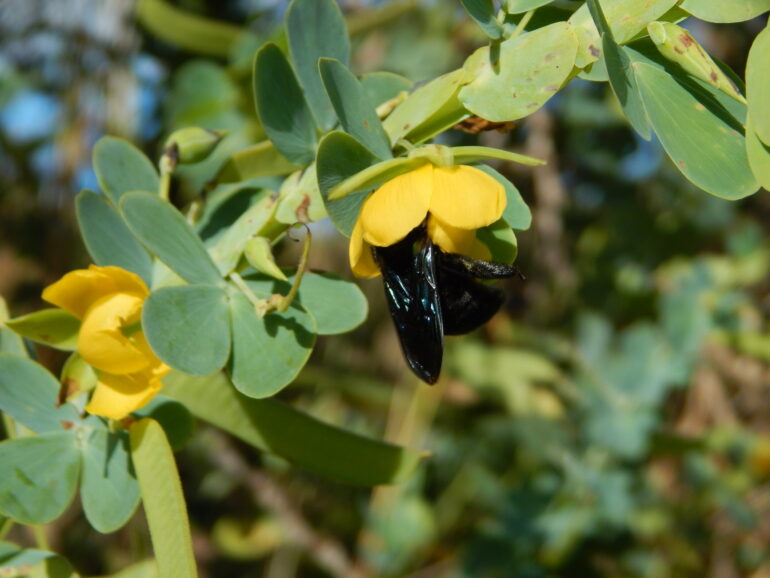Bacteria that live in soil and help roots fix nitrogen can boost certain plants’ capacity to reproduce, according to an article published in the American Journal of Botany describing a study of this mechanism in Chamaecrista latistipula, a legume belonging to the Fabaceae family, which includes beans and peas.
Bacteria in the soil enhance the attractiveness of the plant’s flowers to pollinators via a type of relationship known as mutualism that is widespread in plants and animals. Microorganisms such as bacteria or fungi contribute to and benefit from mutualistic relationships with plants, whereby both sides obtain more nutrients or reproduce more vigorously, for example.
In the case of C. latistipula, a shrub with a native range spanning Bolivia, Brazil and northeast Argentina, the soil it inhabits tends to be nutrient-poor, and it depends on a specific type of pollinator to reproduce.
“Its mutualistic relationship with nitrogen-fixing bacteria increases the supply of the nutrient to its roots in exchange for the sugar on which they feed,” said Anselmo Nogueira, a professor at the Federal University of the ABC’s Center for Natural and Human Sciences (CCNH-UFABC) in São Bernardo do Campo, São Paulo state, Brazil.
“The plant also has a mutualistic relationship with a specific type of pollinator. The pollen stored in its flowers’ anthers is only released when they are made to vibrate, mainly by being shaken by females of some species of bumblebee in the genus Bombus.”
A greenhouse experiment conducted at the Plant-Animal Interaction Laboratory, which Nogueira heads, showed that these bacteria play a significant role in making flowers attractive to bumblebees, especially for plants growing in nutrient-poor soil.
“We also observed a drastic effect that we hadn’t expected. Because the association with bacteria is very costly for the plant, we assumed that in nitrogen-rich soil the plants would simply take nitrogen directly from the soil, but in our experiments nutrient-rich soil didn’t produce healthy plants with attractive flowers,” said Caroline Souza, first author of the article.
The experiment was part of the project “Synergistic effect of multiple mutualists on plants: how bacteria, ants and bees contribute to the evolution of a hyper-diverse lineage of legumes”, which is coordinated by Nogueira.
Bacteria, plant and insect
In the experiment, the researchers monitored the growth of 60 C. latistipula plants from seed germination for 16 months. Half were grown in soil made up mostly of sand (90%) with a thin layer of organic topsoil (10%) and a low concentration of nutrients, especially nitrogen. The other half were grown in soil rich in organic matter and supplemented with potassium nitrate, which releases nitrogen into the soil. Soil acidity was monitored for six months in both cases to ensure that pH was neutral and did not influence root-bacteria interaction.
Before the seeds were sown, they were sterilized with alcohol, sodium hypochlorite and hydrogen peroxide to eliminate bacteria that could influence the results, and were then rinsed in distilled water. The soil was sterilized at a high temperature in an autoclave to eliminate microorganisms.
The two soil types were then submitted to different treatments. A solution containing rhizobia (bacteria that fix nitrogen in plant roots) was added to half the pots with nitrogen-poor sandy soil and half of those with nitrogen-rich organic matter. The rest had no bacteria. The rhizobia used in the experiment were isolated directly from root nodules found on C. latistipula in the wild.
In the nitrogen-poor sandy soil without added bacteria, the plants grew very little and had persistently yellowish leaves owing to lack of nitrogen. The plants grown in nitrogen-poor sandy soil with added rhizobia developed satisfactorily.
“In the nitrogen-poor sandy soil with nitrogen-fixing bacteria, the plants were almost twice as tall and three times larger than those grown in nitrogen-rich soil with organic matter and rhizobia. On the other hand, the plants grown without rhizobia in both sandy soil and soil rich in organic matter were shorter and smaller than those grown with rhizobia,” Nogueira said.
The researchers analyzed the flowers using a surface spectrophotometer, which measures how light is reflected. “Based on flower reflectance measured in this manner, we tested for alterations in the color contrasts perceptible to bumblebees in the different soils with and without bacteria,” Souza said.
Significant differences were detected only in the plants grown in nitrogen-poor sandy soil with rhizobia: their anthers displayed a pattern considered particularly attractive to bumblebees, which perceive the color spectrum differently from humans.
“The anthers contain the pollen and can be accessed only by insects capable of making them vibrate, which can’t be done by exotic species such as the European honeybee Apis mellifera, for example,” Souza explained.
Pollen is an essential source of protein for larvae of all bee species, including bumblebees and other native bees. The nutrients in pollen greatly influence larval growth and development.
After making the measurements, the researchers removed the plants from the pots to analyze their roots. The number of root nodules served as an indication of interaction with rhizobia.
Nodules are knob-like structures that form on the roots of leguminous plants as a result of symbiotic infection by nitrogen-fixing bacteria. The mutualistic relationship with bacteria enables plants to manufacture the amino acids they require.
Amino acids and their derivatives perform many functions in plants, contributing to protein synthesis, development, nutrition, and stress responses. In exchange, plants supply the sugar bacteria need for energy and growth, enabling them to proliferate in the nodules.
In the experiment, the plants grown in nitrogen-poor sandy soil and inoculated with rhizobia had the most nodules.
“Now we want to know whether this pollen, which is accessible only to female native bees, is enriched with proteins and amino acids because of the partnership between plants and bacteria. The heightened attractiveness of the flowers may be associated with larger amounts of high-quality resources, influenced by the roots’ high nitrogen fixation rate,” Nogueira said.
More information:
Caroline Souza et al, Nitrogen‐fixing bacteria boost floral attractiveness in a tropical legume species during nutrient limitation, American Journal of Botany (2024). DOI: 10.1002/ajb2.16363
Citation:
Presence of bacteria in soil makes flowers more attractive to pollinators, study shows (2024, September 26)



